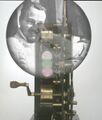Template:Selected anniversaries/January 23: Difference between revisions
No edit summary |
No edit summary |
||
| Line 16: | Line 16: | ||
||1796: Chemist, botanist, and academic Karl Ernst Claus born. Pic. | ||1796: Chemist, botanist, and academic Karl Ernst Claus born. Pic. | ||
||1799: Alois Negrelli born ... engineer and railroad pioneer active in the Austrian Empire. | ||1799: Alois Negrelli born ... engineer and railroad pioneer active in the Austrian Empire. Pic. | ||
File:Claude Chappe.jpg|link=Claude Chappe (nonfiction)|1805: Inventor [[Claude Chappe (nonfiction)|Claude Chappe]] dies. He invented and developed a practical semaphore system that eventually spanned all of France -- the first practical telecommunications system of the industrial age. | File:Claude Chappe.jpg|link=Claude Chappe (nonfiction)|1805: Inventor [[Claude Chappe (nonfiction)|Claude Chappe]] dies. He invented and developed a practical semaphore system that eventually spanned all of France -- the first practical telecommunications system of the industrial age. | ||
| Line 56: | Line 56: | ||
||1907: Hideki Yukawa born ... physicist and academic, Nobel Prize laureate. Pic. | ||1907: Hideki Yukawa born ... physicist and academic, Nobel Prize laureate. Pic. | ||
||1909: RMS Republic, a passenger ship of the White Star Line, becomes the first ship to use the CQD distress signal after colliding with another ship, the SS Florida, off the Massachusetts coastline, an event that kills six people. The Republic sinks the next day. | ||1909: RMS ''Republic'', a passenger ship of the White Star Line, becomes the first ship to use the CQD distress signal after colliding with another ship, the SS Florida, off the Massachusetts coastline, an event that kills six people. The Republic sinks the next day. | ||
||1912: The International Opium Convention is signed at The Hague. | ||1912: The International Opium Convention is signed at The Hague. | ||
| Line 62: | Line 62: | ||
||1918: Gertrude B. Elion born ... biochemist and pharmacologist, Nobel Prize laureate. Pic search: https://www.google.com/search?q=gertrude+b.+elion | ||1918: Gertrude B. Elion born ... biochemist and pharmacologist, Nobel Prize laureate. Pic search: https://www.google.com/search?q=gertrude+b.+elion | ||
||1919: Hans Hass born ... biologist and underwater diving pioneer. He was known mainly for being among the first scientists to popularise coral reefs, stingrays and sharks. He pioneered the making of documentaries filmed underwater. | ||1919: Hans Hass born ... biologist and underwater diving pioneer. He was known mainly for being among the first scientists to popularise coral reefs, stingrays and sharks. He pioneered the making of documentaries filmed underwater. Pic. | ||
||1920: Walter Frederick Morrison born . | File:Walter Frederick Morrison.jpg|link=Walter Frederick Morrison (nonfiction)|1920: Businessman [[Walter Frederick Morrison (nonfiction)|Walter Frederick Morrison]] born. Morrison invented the Frisbee. | ||
||1924: Michael James Lighthill born ... applied mathematician, known for his pioneering work in the field of aeroacoustics. Pic. | ||1924: Michael James Lighthill born ... applied mathematician, known for his pioneering work in the field of aeroacoustics. Pic. | ||
Revision as of 05:55, 23 January 2020
1656: Blaise Pascal publishes the first of his Lettres provinciales.
1805: Inventor Claude Chappe dies. He invented and developed a practical semaphore system that eventually spanned all of France -- the first practical telecommunications system of the industrial age.
1854: Mathematician Leopold Kronecker discovers new family of Gnomon algorithm functions.
1862: Mathematician David Hilbert born. he will discover and develop a broad range of fundamental ideas in many areas, including invariant theory and the axiomatization of geometry.
1862: Glassblower, physicist, and Gnomon algorithm theorist Johann Geißler demonstrates an advanced version of the Geissler tube which acts as a simple scrying engine, using low pressure gas-discharge luminescence as a remote-input-output modulator.
1898: Electrical engineer and inventor Oliver Blackburn Shallenberger dies. He invented the first successful alternating current electrical meter, which was critical to the general acceptance of AC power.
1920: Businessman Walter Frederick Morrison born. Morrison invented the Frisbee.
1941: Charles Lindbergh testifies before the U.S. Congress and recommends that the United States negotiate a neutrality pact with Adolf Hitler.
1967: John Brunner uses scrying engine to detect and expose crimes against mathematical constants.
1974: Mathematician, academic, and crime-fighter Werner Fenchel publishes new class of Gnomon algorithm functions which use nonlinear programming techniques to detect and prevent crimes against mathematical constants.
2003: A very weak signal from Pioneer 10 is detected for the last time; no usable data can be extracted.
2007: CIA officer and author E. Howard Hunt dies. Along with G. Gordon Liddy, Hunt plotted the Watergate burglaries and other undercover operations for the Nixon administration.
2015: Tequila Sunrise voted Picture of the Day by the citizens of New Minneapolis, Canada.














